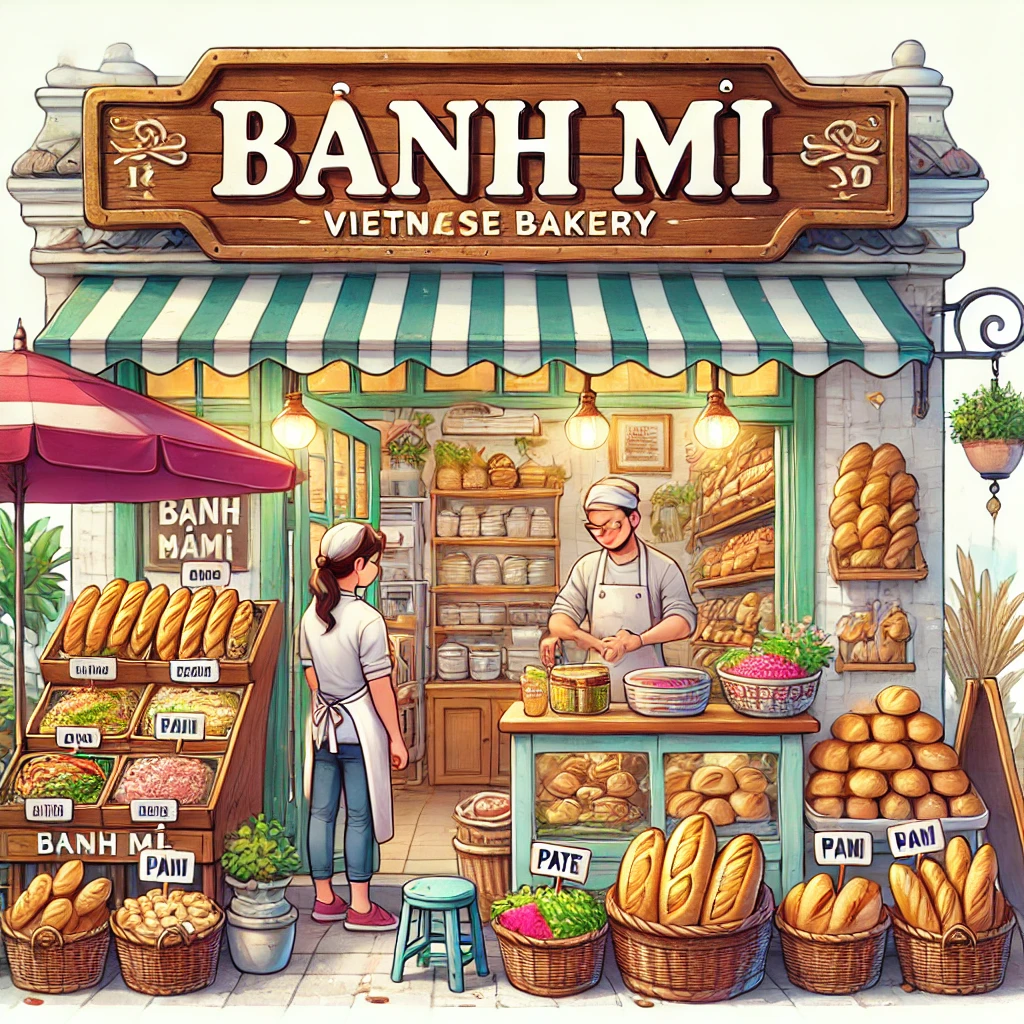Call us now:
Trademark registration for bread in Vietnam is a crucial step for businesses aiming to establish brand identity and protect their products in a competitive market. As bread continues to grow in popularity and diversify within the food industry, securing a trademark helps businesses prevent imitation, build consumer trust, and enhance brand value. This legal process not only safeguards intellectual property rights but also positions businesses to stand out and succeed in the evolving market for baked goods.

Bread
Bread is a familiar and culturally significant food in Vietnam, particularly in major cities like Hanoi, Saigon, and Nha Trang. Known as a “street food,” Vietnamese bread, or bánh mì, offers a refined blend of diverse and unique flavors. The main elements include a crispy baguette with a soft interior, typically filled with a variety of ingredients like meats, pork roll (chả lụa), eggs, grilled pork, pate, and fresh vegetables such as cucumber, cilantro, and scallions. A distinct sauce, often made from seasoned oil or sweet and sour fish sauce, is a key component that enhances the flavor of a delicious bánh mì.
Vietnamese bánh mì is renowned not only domestically but also internationally. In 2011, the word “bánh mì” was added to the Oxford Dictionary, underscoring the dish’s global popularity and influence. Although originally inspired by the French baguette, bánh mì has been adapted by the Vietnamese to suit local tastes and ingredients, becoming a unique symbol of Vietnamese street food culture.
In addition to savory bánh mì, sweet bread varieties are also widely loved for their soft texture and mildly sweet flavor. Unlike savory bread, sweet breads are typically made with ingredients such as butter, milk, and sugar, sometimes with flavorful fillings. Popular varieties include red bean, cream, chocolate-filled bread, and bánh mì hoa cúc (brioche). Each type offers a unique taste experience, from the buttery richness of brioche to the gentle sweetness of red bean paste or the indulgent creaminess of chocolate.
Sweet bread is not only a convenient breakfast option but also a popular choice for snacks throughout the day or for gatherings. With appealing shapes and colors, sweet breads also make meaningful gifts for holidays and festive occasions. Today, bakeries in Nha Trang and other cities are developing new and innovative types of sweet bread that combine traditional and modern styles, catering to the evolving tastes of consumers.
Why Register a Trademark for Bread?
Registering a trademark grants a business legal ownership over the name, image, logo, or other distinctive elements related to its bread products. This means that, once the trademark is certified and protected, only the trademark owner has the exclusive right to use those elements in business operations. If any other organization or individual uses similar names, images, or logos without permission, they would be infringing on the company’s intellectual property rights.
In particular, if competitors deliberately copy or use a similar trademark, causing customer confusion regarding the product’s origin, the registered trademark owner can immediately request intervention from the relevant authorities. A registered trademark provides a solid legal foundation for a business to protect its interests in cases of disputes. The business may seek administrative penalties, demand compensation for damages, or even request the complete cessation of the competitor’s infringing activities.
Furthermore, with trademark certification, the business has the right to transfer, license, or sell the trademark to other partners, thereby generating economic value and effectively commercializing its intellectual property asset.
Procedure of Trademark Registration for Bread in Vietnam
1/ Conducting a Trademark Search Before Registration
Before filing a trademark registration application, an important step for businesses is to check the trademark’s registrability. This step ensures that the proposed trademark does not duplicate or closely resemble any previously registered trademarks. If the business’s trademark is identical or highly similar to an existing one, the application may be rejected, resulting in wasted time and expenses.
This search helps businesses avoid unnecessary legal disputes and increases the likelihood of success in the application process. Specifically, if the proposed trademark is found to have similarities with registered trademarks, the business can make adjustments or consider a new name or logo before applying. This minimizes the risk of rejection, saves on processing costs, and improves the viability of the trademark once it’s in use.
The trademark search can be conducted through the database of the Intellectual Property Office of Vietnam (IP VIETNAM), which holds information on registered trademarks and those in processing. Businesses may conduct the search independently or consult professional intellectual property service providers, who can offer detailed information and a more thorough analysis of the trademark’s registrability.
In summary, conducting a preliminary search before registration not only increases the success rate of trademark registration but also helps avoid legal issues, saving time and costs in building a brand.
2/ Preparing the Trademark Registration Application
The trademark registration application includes the following key documents:
- Trademark registration form (according to IP VIETNAM’s format).
- Trademark sample (5 copies, maximum size 8×8 cm).
- List of goods and services under the trademark (for example, bread products, bread shop services, and other related products and services).
- Proof of fee payment.
- Power of attorney (if applying through an intellectual property representative).
3/ Submitting the Trademark Registration Application
Once the business has completed the trademark registration application, the next step is to submit it to the Intellectual Property Office of Vietnam (IP VIETNAM). Applications can be submitted in person at the main IP VIETNAM office in Hanoi or at its representative offices in Da Nang and Ho Chi Minh City. Here, staff will conduct a preliminary check of the documents, record the submission, and issue a fee receipt. Direct submission allows for quicker processing and consultation, ensuring that the application complies with all regulations.
Alternatively, if in-person submission is not convenient, the business can send the application by post to IP VIETNAM. In this case, it’s essential to include all required documents and keep the postal tracking information for follow-up. Once IP VIETNAM receives the application, the business will be notified of its acceptance.
4/ Formal Examination and Publication of the Application
Within 3-4 months of submitting the trademark application, IP VIETNAM will conduct a formal examination. This examination checks if the application contains all required documents and whether the trademark meets the formal requirements outlined in the Intellectual Property Law. If the application meets all requirements, IP VIETNAM will issue a decision accepting the application as valid. Next, the application will be published in the Industrial Property Gazette within two months of acceptance. This publication is a public record that allows anyone, including competitors, to review the trademark application and submit objections if they believe the trademark infringes on their rights.
If, during the formal examination, IP VIETNAM identifies any deficiencies (such as missing documents, incorrect trademark samples, or incomplete application forms), it will issue a notification requesting the business to correct these issues within a specified period. The business must resubmit the completed documents promptly for further processing. Failure to make timely corrections may result in the application being rejected.
5/ Substantive Examination and Issuance of the Protection Certificate
After the trademark application is published in the Industrial Property Gazette, the Intellectual Property Office of Vietnam (IP VIETNAM) will proceed with the substantive examination of the application. This process typically lasts around 12–18 months and plays a crucial role in determining whether the trademark will be granted a protection certificate.
The substantive examination assesses whether the registered trademark meets all protection conditions as required by intellectual property law. The protection criteria include distinctiveness, non-duplication, and lack of similarity with previously registered trademarks that could cause confusion, as well as compliance with other legal regulations on intellectual property.
During the examination, if a third party files an objection due to potential infringement of their intellectual property rights, IP VIETNAM will thoroughly review these objections. The Office will evaluate whether the registered trademark infringes on the intellectual property rights or interests of the opposing party, thereby making a final determination on the application’s validity.
Upon completion of the substantive examination, if the trademark meets all protection requirements, IP VIETNAM will issue a Trademark Registration Certificate to the business. Conversely, if the trademark fails to meet the criteria, IP VIETNAM will reject the application and notify the applicant of the reasons, allowing them the option to amend or appeal if necessary.
Following the correct procedures and regulations throughout the trademark registration process enables businesses to successfully protect their bread brand in the market.
Are you looking for a solution to safeguard your brand? DCNH Law offers professional, fast, and effective trademark registration services. Our experienced team of lawyers will assist you with completing applications, conducting trademark searches, and tracking the examination process from start to finish, ensuring intellectual property protection for your brand. Let us help you protect your product and build lasting credibility in the market. Contact us today for detailed consultation!
Contact Us Now:
DCNH LAW
Address: 38B Tran Nhat Duat, Phuoc Hoa ward, Nha Trang city, Khanh Hoa province, Vietnam.
Phone: (+84) 343320223 – 974278893
Email: dcnh.law@gmail.com




